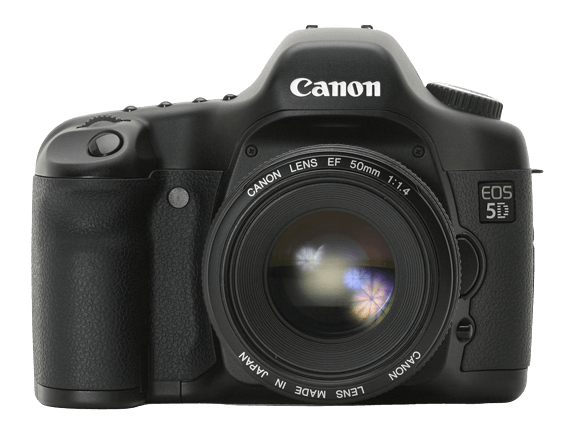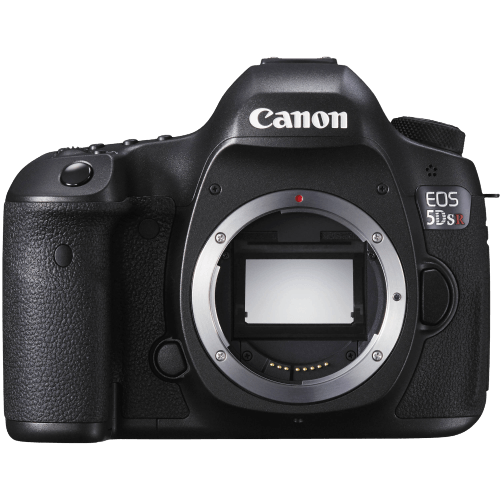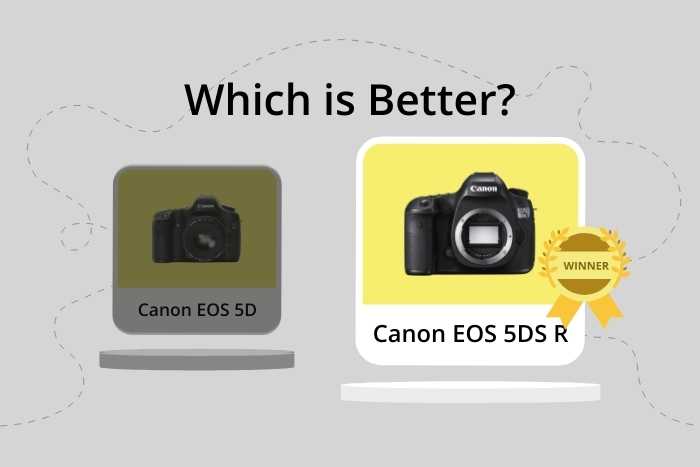Canon EOS 5D vs EOS 5DS R Comparison
Canon EOS 5D

Canon EOS 5DS R

The Canon EOS 5DS R outperforms the Canon EOS 5D with a score of 68/100 compared to the latter’s 40/100. Both cameras are DSLRs and share similar dimensions, with the 5D measuring 152 x 113 x 75mm and weighing 895g, while the 5DS R measures 152 x 116 x 76mm and weighs 930g.
Despite their similarities, the 5DS R has the upper hand due to its more recent release in 2015 and a higher launch price of $3900, whereas the 5D was released in 2005 for $2000. This difference in price and release date reflects the advancements and improvements made to the 5DS R.
On the other hand, the 5D might be more suitable for those on a tighter budget or who prefer a slightly lighter camera. However, the 5DS R’s higher score indicates that it is a superior camera in terms of performance and capabilities. When choosing between these two options, consider your needs, budget, and preferences to make the best decision.
Canon EOS 5D vs EOS 5DS R Overview and Optics
The Canon EOS 5DS R emerges as the winner in the optics comparison, with a score of 73/100, outperforming the Canon EOS 5D, which scores 46/100. Both cameras have several common specifications, including a CMOS sensor, a full-frame sensor size, a Canon EF lens mount, and no image stabilization.
The Canon EOS 5DS R excels with its 50.6-megapixel resolution, significantly higher than the 12.7 megapixels offered by the Canon EOS 5D. This results in sharper, more detailed images captured by the EOS 5DS R. Additionally, the EOS 5DS R has a faster shooting speed of 5 frames per second, compared to the EOS 5D’s 3 frames per second. This enables the EOS 5DS R to capture fast-moving subjects more effectively. Moreover, the EOS 5DS R features a superior Dual Digic 6 processor and a higher DXOMARK sensor score of 86, which contributes to better image quality and faster processing.
The Canon EOS 5D, despite its lower score, has some advantages. Its 12.7-megapixel resolution may be sufficient for photographers who do not require extremely high-resolution images, and it may also result in smaller file sizes, which can be beneficial for storage and processing. However, the EOS 5D’s lower shooting speed and older Digic II processor may limit its performance in certain situations.
Taking these factors into account, the Canon EOS 5DS R is the better choice for photographers seeking higher resolution, faster shooting speed, and better overall image quality. On the other hand, the Canon EOS 5D may still be suitable for those who prioritize smaller file sizes and do not require the advanced features of the EOS 5DS R.
Canon EOS 5D vs EOS 5DS R Video Performance
When examining the video capabilities of the Canon EOS 5D and Canon EOS 5DS R, it is essential to note that the Canon EOS 5D does not have any video functionality. This lack of video recording features sets it apart from the Canon EOS 5DS R, which does have video capabilities.
The Canon EOS 5DS R has a video score of 57 out of 100, indicating that it is capable of capturing video, albeit not at the highest quality. Its maximum video resolution is Full HD, with dimensions of 1920 x 1080. The camera can record video at a maximum frame rate of 30fps, which is standard for Full HD video recording. Additionally, the Canon EOS 5DS R has built-in time-lapse functionality, allowing users to create time-lapse videos without needing external equipment or software.
Taking into consideration the video capabilities of both cameras, it is clear that the Canon EOS 5DS R is the more versatile option for photographers who require video recording features. While the Canon EOS 5D may be a suitable choice for those solely interested in photography, the Canon EOS 5DS R provides the added benefit of video recording, making it a more comprehensive option for users seeking a camera with a broader range of features.
Canon EOS 5D vs EOS 5DS R Features and Benefits
The Canon EOS 5DS R emerges as the winner in the features comparison, scoring 59 points, while the Canon EOS 5D scores 30 points. Both cameras share some specifications, such as lacking a touchscreen, flip screen, GPS, and Bluetooth. However, each camera offers unique advantages that set them apart.
The Canon EOS 5DS R excels with its larger 3.2-inch screen and significantly higher screen resolution of 1,040,000 dots, providing a clearer and more detailed display for easier menu navigation and image review. This difference in screen size and resolution gives the 5DS R a substantial edge over the 5D, which has a smaller 2.5-inch screen and a lower resolution of 230,000 dots.
On the other hand, the Canon EOS 5D offers Wi-Fi connectivity, a feature that the 5DS R lacks. This advantage allows users to transfer images wirelessly and control the camera remotely using a compatible smartphone or tablet. Despite its lower feature score, the 5D’s Wi-Fi connectivity may be a valuable asset for some photographers.
Both cameras excel in different areas, with the Canon EOS 5DS R offering a superior screen for improved user experience, while the Canon EOS 5D provides the convenience of Wi-Fi connectivity. Ultimately, the choice between these two cameras depends on the individual photographer’s priorities and preferences, as each camera presents its own unique advantages.
Canon EOS 5D vs EOS 5DS R Storage and Battery
The Canon EOS 5DS R outperforms the Canon EOS 5D in storage and battery, scoring 65/100 compared to the 5D’s 24/100. Both cameras lack USB charging and accept Compact Flash memory cards. However, the 5DS R has the advantage of two memory card slots, supporting SD/SDHC/SDXC (UHS-I compatible) cards in addition to Compact Flash.
In terms of battery life, the 5DS R provides 700 shots with its LP-E6 battery, while the 5D offers 400 shots using a BP-511A battery. This significant difference makes the 5DS R a more reliable choice for extended shooting sessions.
The only advantage the 5D has over the 5DS R in this category is its compatibility with both Type I and II Compact Flash cards. However, this is a minor advantage compared to the 5DS R’s dual memory card slots and longer battery life.
Taking these factors into account, the Canon EOS 5DS R is the clear winner in storage and battery performance, offering greater flexibility and endurance for photographers.
Canon EOS 5D vs EOS 5DS R Alternatives
If you’re still unsure which camera is best for you, get inspired with some of our other popular comparisons:

